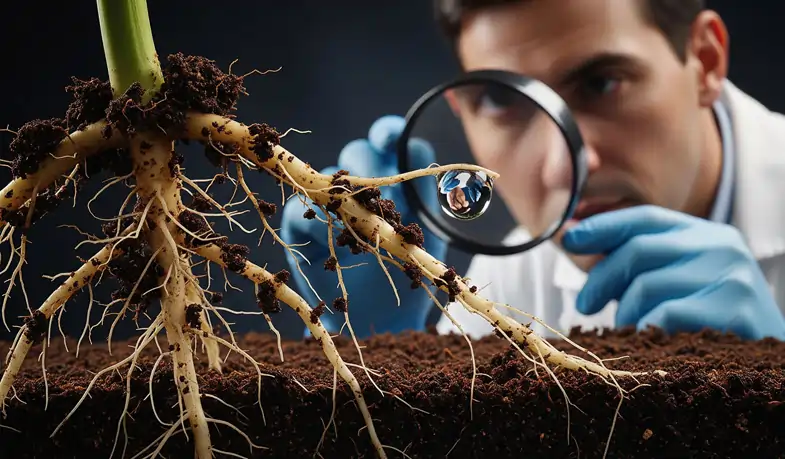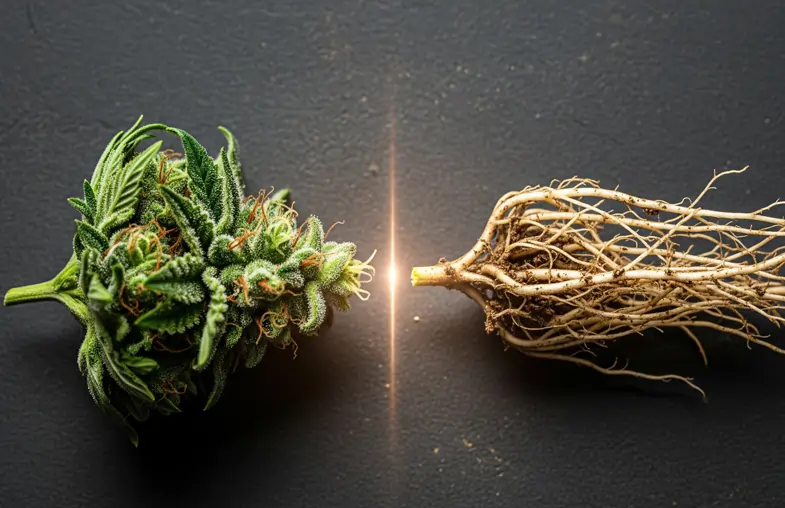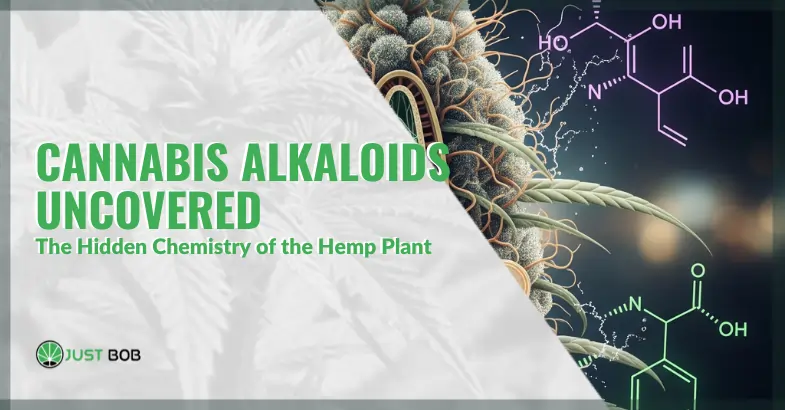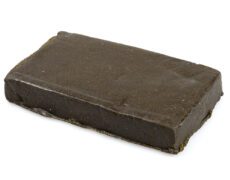Modified on: 15/11/2025
Beyond Cannabinoids and Terpenes: Exploring a New Class of Compounds
When we talk about the chemistry of the cannabis plant, the conversation almost invariably turns to cannabinoids like THC and CBD, or perhaps the aromatic terpenes that define the plant’s unique scent and flavour profiles. For decades, these two families of compounds have dominated scientific research, commercial development, and public discussion.
But beneath this well-trodden surface lies a deeper, more mysterious layer of chemical constituents: the alkaloids. These compounds, though present in much smaller quantities, represent a fascinating and largely unexplored frontier in our understanding of Cannabis Sativa L.
Unlike their more famous chemical cousins, alkaloids have a distinct structure and origin, hinting at different roles within the plant’s biology. As interest in every facet of the hemp plant grows, from its fibres to its flowers, scientists are beginning to turn their attention to this elusive group of molecules.
This article, written by JustBob, will delve into the world of cannabis alkaloids, shedding light on what they are, where they are found, how they differ from cannabinoids, and why they are capturing the imagination of researchers.
It’s a journey into the hidden chemical heart of one of the world’s most complex botanicals.
Read also: What is the cannabis origin ? Here is its history
What Exactly Are Alkaloids? A Broader Chemical Perspective
Before we zoom in on cannabis, it’s helpful to understand what alkaloids are in a general sense. The term ‘alkaloid’ refers to a vast and diverse group of naturally occurring organic compounds that, in their most basic definition, contain at least one nitrogen atom in their structure.
This nitrogen content is key, as it often imparts basic, or ‘alkaline’, properties to the molecule—hence the name. If this sounds a bit technical, think of some of the most famous plant-derived substances known to humanity: caffeine from coffee beans, nicotine from tobacco leaves, and morphine from the opium poppy are all classic examples of alkaloids.
They are renowned for their potent physiological effects on the human body.
Found across the plant kingdom, alkaloids are believed to serve various functions for the plant itself, often acting as defensive agents against herbivores and pathogens. Their bitter taste can deter animals from eating them, while their toxicity can be lethal to insects.
The discovery of alkaloids in the cannabis plant was a relatively recent development, adding another layer of complexity to a botanical already brimming with over 500 chemical compounds.
This discovery challenges us to look beyond just the flowering tops, reminding us that every part of the plant has a unique story to tell.


The Primary Alkaloids Identified in Cannabis Sativa
While the cannabinoid family boasts over 100 different members, the list of known cannabis alkaloids is currently much shorter, reflecting how nascent the research in this area truly is. The first significant breakthrough came in the 1970s, when scientists managed to isolate and identify two specific alkaloids from the roots and other parts of the cannabis plant.
These were named, fittingly, cannabisativine and anhydrocannabisativine. These were the pioneers, the first evidence that cannabis produced these nitrogen-containing compounds. Since then, further research has identified other alkaloids, though often in trace amounts.
One of the most notable is hordenine (also known as N,N-dimethyltyramine), an alkaloid that is not exclusive to cannabis and can also be found in plants like barley. Other spermidine alkaloids such as N-methyl-spermidine have also been noted by researchers.
It is crucial to understand that the concentration of these alkaloids is significantly lower than that of cannabinoids.
While CBD can make up a substantial percentage of the dry weight of a legal hemp flower, alkaloids are present in minute quantities, making their extraction and study a considerable scientific challenge. This rarity and subtlety is part of what makes them so intriguing to botanical enthusiasts.
Alkaloids vs. Cannabinoids and Terpenes: Understanding the Key Differences
To truly appreciate what makes cannabis alkaloids unique, it’s essential to distinguish them from cannabinoids and terpenes. The most fundamental difference lies in their basic chemical structure.
Alkaloids, by definition, contain nitrogen; cannabinoids and terpenes do not. This single atomic difference places them in entirely separate classes of organic compounds and is responsible for their different chemical properties.
The second major distinction is their location and concentration within the plant. Cannabinoids, like CBD and CBG, are predominantly synthesised and stored in the glandular trichomes found on the surface of the plant’s flowers and leaves. Terpenes are also concentrated in these same trichomes. This is why the inflorescences of cannabis light, prized for collection and aromatherapy, are so rich in these compounds.
Alkaloids, on the other hand, seem to be found primarily in the roots and seeds of the plant. This geographical separation within the plant suggests they perform entirely different biological functions. While cannabinoids and terpenes in the flower may play a role in attracting pollinators and deterring pests from the reproductive parts, the alkaloids in the root system might be more involved in soil interactions and defence against subterranean threats.
Where Are Alkaloids Located in the Cannabis Plant?
As we’ve touched upon, the location of alkaloids is a key piece of the puzzle. While the glistening trichomes on a high-quality hemp flower are veritable factories for cannabinoids and terpenes, you won’t find many alkaloids there.
Instead, researchers have had to look deeper, into the parts of the plant that are often overlooked. The primary location for alkaloids is the root system. The roots are a plant’s anchor and its interface with the complex world of the soil, absorbing nutrients and water while fending off fungi, bacteria, and nematodes.
It is hypothesised that alkaloids like hordenine play a role in this subterranean defence system. Beyond the roots, trace amounts of alkaloids have also been detected in the seeds and, to a lesser extent, the stems. This distribution is incredibly significant because it means that most traditional uses and studies of cannabis, which have focused almost exclusively on the flowers and leaves, would have completely missed their presence.
This highlights a holistic view of the plant, where even the parts that aren’t used for creating products like CBD oil possess their own unique and valuable chemical secrets. The study of alkaloids forces us to appreciate the Cannabis Sativa L. plant in its entirety, from the tip of its tallest leaf to the end of its deepest root.
The Current State of Scientific Research into Cannabis Alkaloids
The scientific journey into cannabis alkaloids is very much in its infancy. For every thousand studies on cannabinoids, there might only be a handful that focus on these nitrogenous compounds. This is largely due to their low concentrations and the difficulty in isolating sufficient quantities for rigorous analysis.
However, the interest is growing. Current research is primarily focused on a few key areas.
Firstly, basic identification and quantification: scientists are still working to create a complete catalogue of all the alkaloids present in cannabis and to understand how their concentrations vary between different cultivars and growing conditions.
Secondly, biosynthesis: researchers are trying to map out the chemical pathways the plant uses to create these alkaloids. Understanding how they are made could provide clues about their function.
Finally, there is preclinical research into their potential biological activity. It’s important to state clearly that this research is exploratory and far from yielding conclusive results about their effects.
This nascent field of study is akin to botanical archaeology, requiring highly specialised tools and unwavering patience. The minute quantities involved mean that each discovery is a hard-won victory for analytical chemists. Progress is therefore methodical and incremental, far from the rapid pace of development seen in cannabinoid science.
It underscores a fundamental truth: the more we learn about the cannabis plant, the more we realise how much is yet to be uncovered. This journey into the unknown is what makes every botanical specimen a source of endless fascination.
The scientific community is driven by curiosity, exploring whether these molecules interact with biological systems in ways that are distinct from cannabinoids.
This field is a perfect example of how much we still have to learn, reminding collectors of items like CBD hash that the botanical world is full of undiscovered wonders.


Hordenine in Cannabis: An Interesting Case Study
Among the few alkaloids identified in cannabis, hordenine stands out as a particularly interesting case. Unlike cannabisativine, which is unique to the cannabis genus, hordenine is found in a variety of other plants, most notably in malted barley, where it contributes to the flavour of beer.
Its presence in cannabis, primarily within the roots, has prompted specific scientific inquiry.
As a phenylethylamine alkaloid, its structure has drawn comparisons to other well-known bioactive amines. Researchers have investigated hordenine in various contexts outside of cannabis, exploring its properties in laboratory settings. Its identification within the cannabis plant broadens our understanding of the plant’s chemical repertoire, showing that it doesn’t just create unique compounds but also incorporates molecules found elsewhere in the botanical kingdom.
This serves as a powerful reminder of the interconnectedness of plant biology.
For those who appreciate the finer details of botanicals, perhaps for collection or as decorative pieces, knowing that a plant contains such a diverse and complex array of compounds adds another layer of appreciation.
The presence of hordenine reinforces the idea that the hemp plant is a masterful chemist, borrowing and inventing molecules for its own survival and growth, a fact that makes every part of it, from flower to root, a subject of fascination.
Read also: Cannabinoids: short and long term effects
Conclusion: The Unfolding Story of Cannabis Chemistry
In conclusion, the world of cannabis alkaloids is a testament to how much we still have to learn about this incredibly complex plant. For years, our focus has been fixed on the dazzling duo of cannabinoids and terpenes, yet in the shadows, the alkaloids have been waiting to be discovered.
These nitrogen-containing compounds represent a completely different branch of the plant’s chemical family tree, distinguished by their unique structure, their primary location in the roots and seeds, and their likely role as defensive agents.
While research is still in its early days and their full significance remains a mystery, their very existence enriches our appreciation for the botanical sophistication of Cannabis Sativa L. They remind us that the plant is more than just its flowers; it is a holistic system where every part has a purpose and a unique chemical signature.
As science continues to delve deeper, our understanding will undoubtedly grow, adding new chapters to an already fascinating story. This journey of discovery mirrors the appreciation held by enthusiasts for the plant’s complexity.
It is important to remember that in many European countries, products derived from hemp—such as oils and inflorescences—even when purchased from a CBD online shop, are intended solely for purposes such as collection, research, or technical use, and not for consumption, in full respect of the plant’s intricate nature and the laws in force (you can read the regulations in the United Kingdom here).
Cannabis Alkaloids: takeaways
- Unlike cannabinoids and terpenes, which lack nitrogen in their structure, alkaloids are nitrogen-containing compounds that play different biological roles in the cannabis plant. Their presence mainly in the roots and seeds, rather than in the trichomes of the flowers, suggests they may be involved in subterranean defence mechanisms rather than pollinator attraction or aroma.
- Research into cannabis alkaloids is still in its early stages, and only a handful of these compounds have been isolated—often in trace amounts. Hordenine, in particular, has gained attention due to its presence in other plants and its potential bioactivity, which opens up new avenues for phytochemical and pharmacological exploration.
- Because they occur in such small quantities and are often found in overlooked parts of the plant like the roots, studying cannabis alkaloids requires advanced analytical methods and significant persistence. Yet, this difficulty is precisely what makes them exciting: their discovery reshapes our understanding of Cannabis Sativa L., showing that its chemistry is more diverse and intricate than previously assumed.
Cannabis Alkaloids: FAQ
What are alkaloids in the context of the cannabis plant?
Alkaloids are nitrogen-containing organic compounds found in many plants and recently discovered in cannabis. Unlike cannabinoids and terpenes, alkaloids have a unique structure and are mainly located in the roots and seeds. They are believed to play a role in plant defense, protecting against pests and microorganisms. Though present in very low amounts, these compounds add depth to the chemical profile of cannabis. Their recent discovery has sparked interest in further scientific exploration.
How are cannabis alkaloids different from cannabinoids and terpenes?
Alkaloids differ significantly from cannabinoids and terpenes in terms of structure and location within the plant. While cannabinoids and terpenes are found mostly in the trichomes of flowers and leaves, alkaloids are found in roots and seeds. Chemically, alkaloids contain nitrogen, which sets them apart. Functionally, they are thought to aid in defense against soil-borne threats rather than contribute to aroma or psychoactive effects. This makes them a unique area of study.
Where in the cannabis plant are alkaloids typically found?
Cannabis alkaloids are mainly located in the plant’s root system. They are not concentrated in the flower trichomes like cannabinoids and terpenes. Instead, researchers have found them in roots, seeds, and occasionally stems. Their role may involve root health and protection from underground threats. This location explains why alkaloids have often been overlooked in studies that focus only on the aerial parts of the plant.









